Analysis of Infrastructure Management Concepts and Issues
VerifiedAdded on 2021/04/17
|7
|1540
|82
Report
AI Summary
This report delves into the multifaceted realm of infrastructure management, encompassing a range of crucial concepts and their practical applications. It begins by defining key terminologies such as Electronic Records Management, Business Intelligence, Business Analytics, Data Mining, Text Mining, Big Data Analytics, Data Discovery, Enterprise Architecture, Management Information Systems, Data Lifecycle, Data Principles, and Cloud Computing. The report then explores the role of data and text mining in creating business value through association rule learning and cluster analysis. It also addresses the challenges associated with cloud computing, including security and data loss issues, providing relevant examples and potential solutions. Furthermore, the report examines the Executive Information System (EIS), its common problems, and strategies for improvement. Finally, it analyzes real-world examples, such as Coca-Cola's use of data analytics in retail and customer experience management, along with the application of the Black Book model to reduce uncertainties in product development. The report draws on various sources to provide a comprehensive overview of the subject.
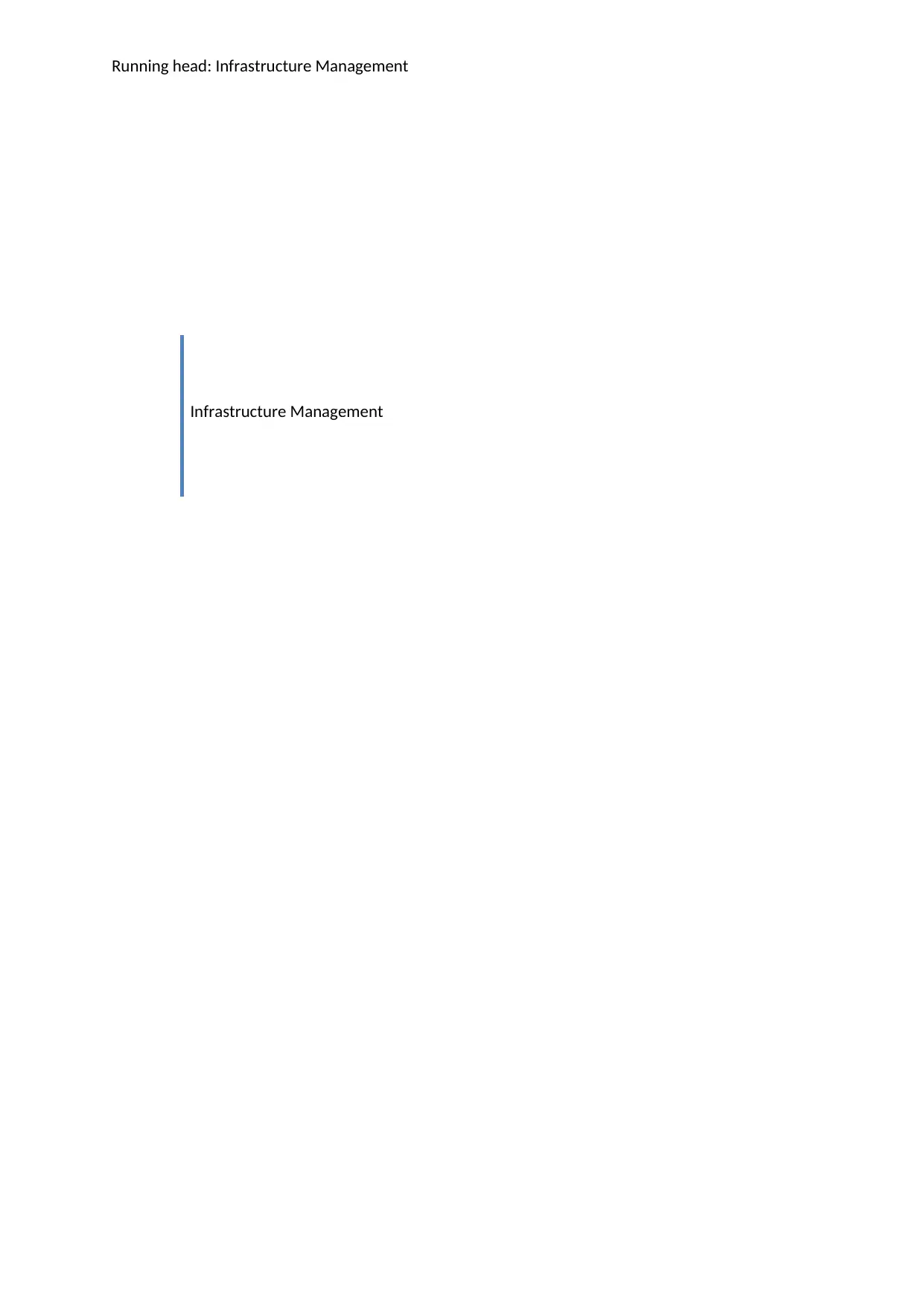
Running head: Infrastructure Management
Infrastructure Management
Infrastructure Management
Paraphrase This Document
Need a fresh take? Get an instant paraphrase of this document with our AI Paraphraser
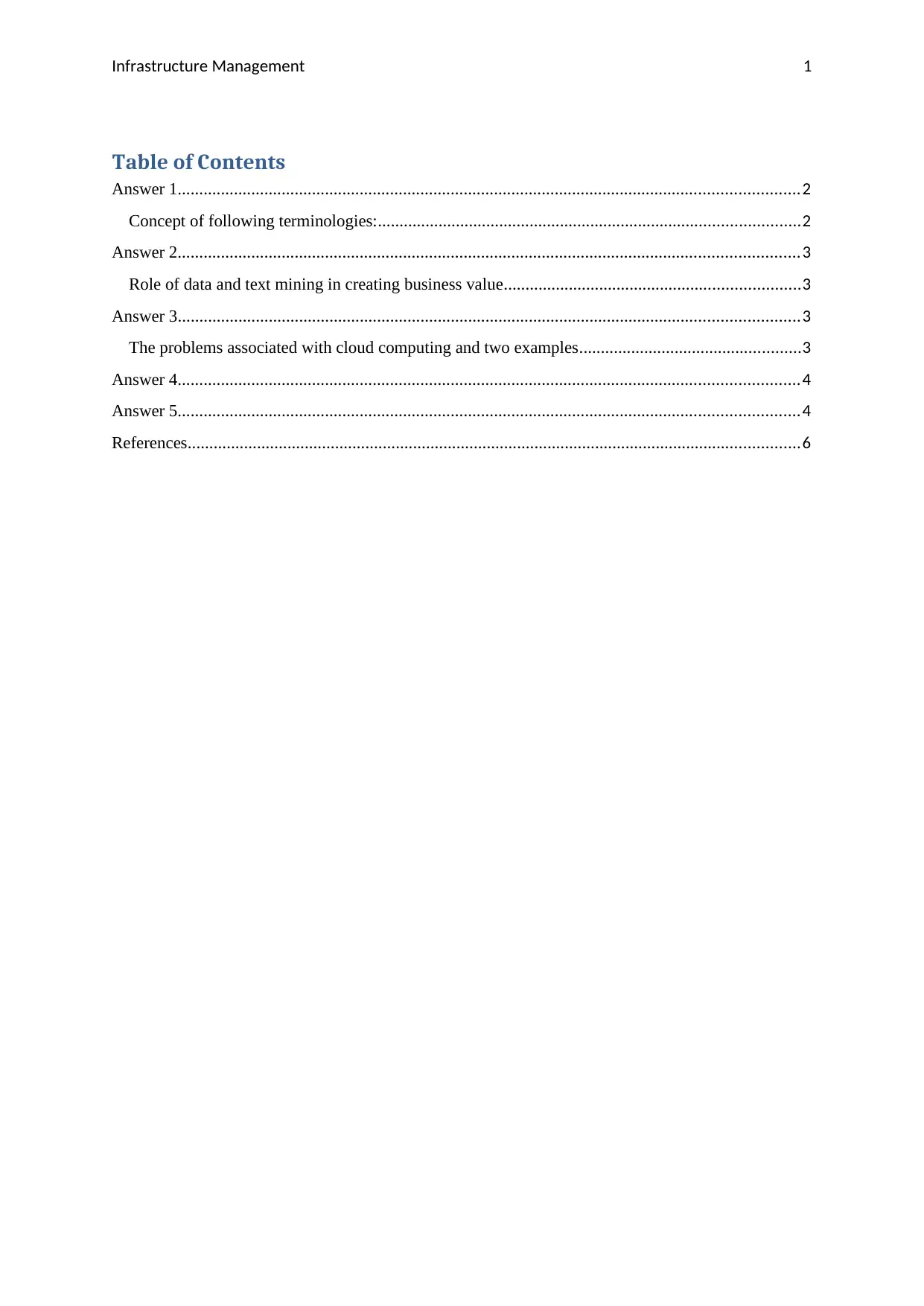
Infrastructure Management 1
Table of Contents
Answer 1...............................................................................................................................................2
Concept of following terminologies:.................................................................................................2
Answer 2...............................................................................................................................................3
Role of data and text mining in creating business value....................................................................3
Answer 3...............................................................................................................................................3
The problems associated with cloud computing and two examples...................................................3
Answer 4...............................................................................................................................................4
Answer 5...............................................................................................................................................4
References.............................................................................................................................................6
Table of Contents
Answer 1...............................................................................................................................................2
Concept of following terminologies:.................................................................................................2
Answer 2...............................................................................................................................................3
Role of data and text mining in creating business value....................................................................3
Answer 3...............................................................................................................................................3
The problems associated with cloud computing and two examples...................................................3
Answer 4...............................................................................................................................................4
Answer 5...............................................................................................................................................4
References.............................................................................................................................................6
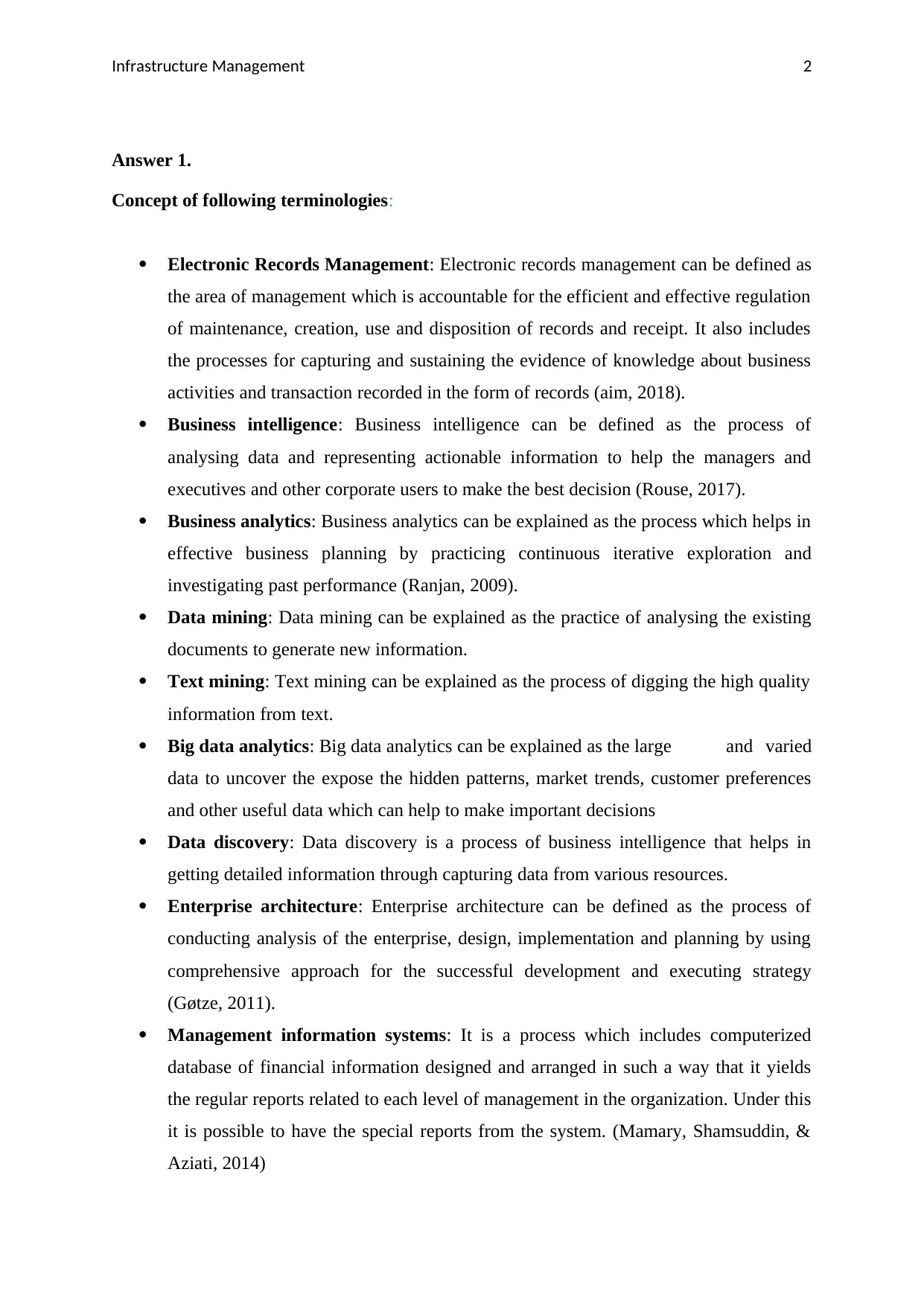
Infrastructure Management 2
Answer 1.
Concept of following terminologies:
Electronic Records Management: Electronic records management can be defined as
the area of management which is accountable for the efficient and effective regulation
of maintenance, creation, use and disposition of records and receipt. It also includes
the processes for capturing and sustaining the evidence of knowledge about business
activities and transaction recorded in the form of records (aim, 2018).
Business intelligence: Business intelligence can be defined as the process of
analysing data and representing actionable information to help the managers and
executives and other corporate users to make the best decision (Rouse, 2017).
Business analytics: Business analytics can be explained as the process which helps in
effective business planning by practicing continuous iterative exploration and
investigating past performance (Ranjan, 2009).
Data mining: Data mining can be explained as the practice of analysing the existing
documents to generate new information.
Text mining: Text mining can be explained as the process of digging the high quality
information from text.
Big data analytics: Big data analytics can be explained as the large and varied
data to uncover the expose the hidden patterns, market trends, customer preferences
and other useful data which can help to make important decisions
Data discovery: Data discovery is a process of business intelligence that helps in
getting detailed information through capturing data from various resources.
Enterprise architecture: Enterprise architecture can be defined as the process of
conducting analysis of the enterprise, design, implementation and planning by using
comprehensive approach for the successful development and executing strategy
(Gøtze, 2011).
Management information systems: It is a process which includes computerized
database of financial information designed and arranged in such a way that it yields
the regular reports related to each level of management in the organization. Under this
it is possible to have the special reports from the system. (Mamary, Shamsuddin, &
Aziati, 2014)
Answer 1.
Concept of following terminologies:
Electronic Records Management: Electronic records management can be defined as
the area of management which is accountable for the efficient and effective regulation
of maintenance, creation, use and disposition of records and receipt. It also includes
the processes for capturing and sustaining the evidence of knowledge about business
activities and transaction recorded in the form of records (aim, 2018).
Business intelligence: Business intelligence can be defined as the process of
analysing data and representing actionable information to help the managers and
executives and other corporate users to make the best decision (Rouse, 2017).
Business analytics: Business analytics can be explained as the process which helps in
effective business planning by practicing continuous iterative exploration and
investigating past performance (Ranjan, 2009).
Data mining: Data mining can be explained as the practice of analysing the existing
documents to generate new information.
Text mining: Text mining can be explained as the process of digging the high quality
information from text.
Big data analytics: Big data analytics can be explained as the large and varied
data to uncover the expose the hidden patterns, market trends, customer preferences
and other useful data which can help to make important decisions
Data discovery: Data discovery is a process of business intelligence that helps in
getting detailed information through capturing data from various resources.
Enterprise architecture: Enterprise architecture can be defined as the process of
conducting analysis of the enterprise, design, implementation and planning by using
comprehensive approach for the successful development and executing strategy
(Gøtze, 2011).
Management information systems: It is a process which includes computerized
database of financial information designed and arranged in such a way that it yields
the regular reports related to each level of management in the organization. Under this
it is possible to have the special reports from the system. (Mamary, Shamsuddin, &
Aziati, 2014)
⊘ This is a preview!⊘
Do you want full access?
Subscribe today to unlock all pages.

Trusted by 1+ million students worldwide
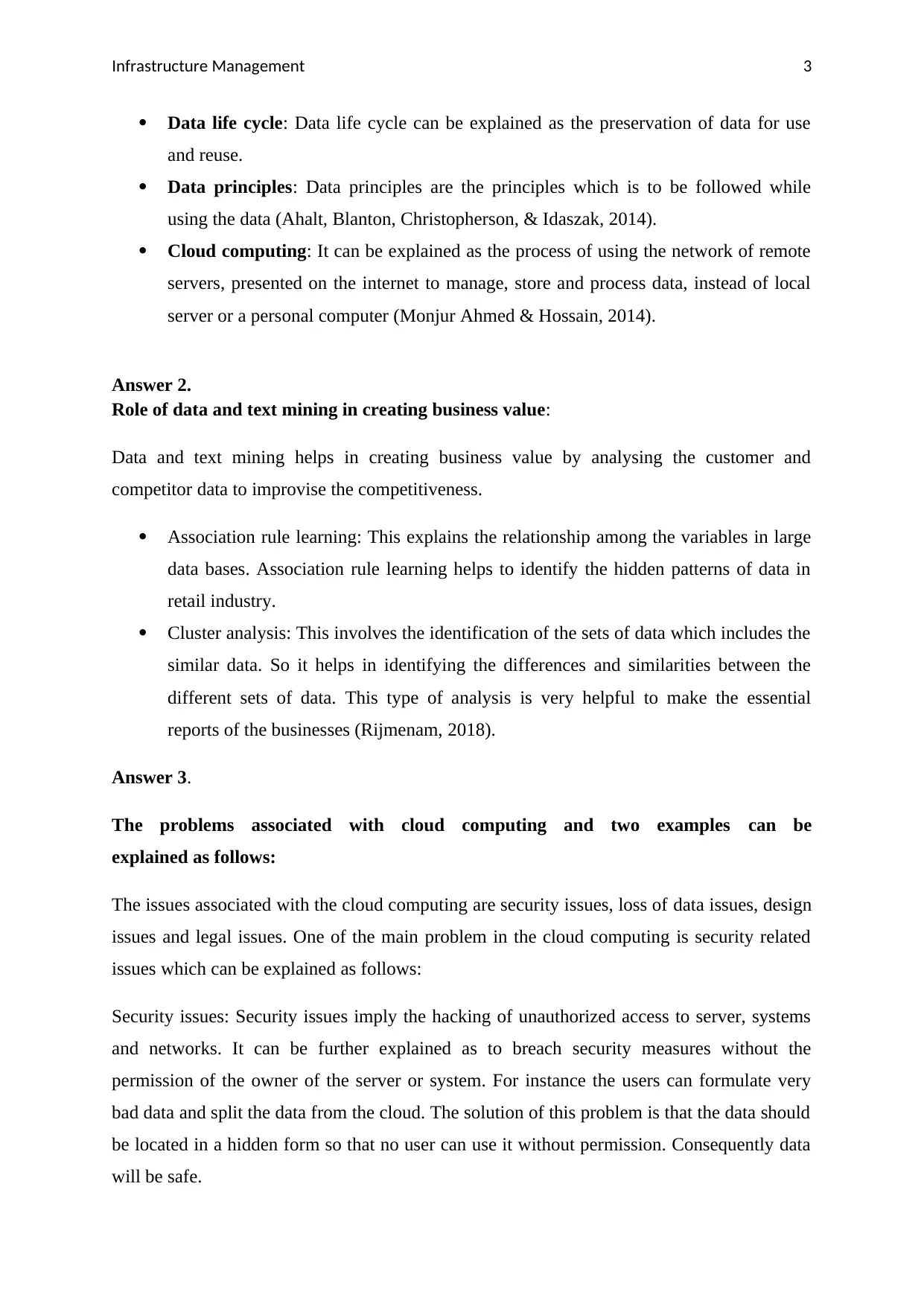
Infrastructure Management 3
Data life cycle: Data life cycle can be explained as the preservation of data for use
and reuse.
Data principles: Data principles are the principles which is to be followed while
using the data (Ahalt, Blanton, Christopherson, & Idaszak, 2014).
Cloud computing: It can be explained as the process of using the network of remote
servers, presented on the internet to manage, store and process data, instead of local
server or a personal computer (Monjur Ahmed & Hossain, 2014).
Answer 2.
Role of data and text mining in creating business value:
Data and text mining helps in creating business value by analysing the customer and
competitor data to improvise the competitiveness.
Association rule learning: This explains the relationship among the variables in large
data bases. Association rule learning helps to identify the hidden patterns of data in
retail industry.
Cluster analysis: This involves the identification of the sets of data which includes the
similar data. So it helps in identifying the differences and similarities between the
different sets of data. This type of analysis is very helpful to make the essential
reports of the businesses (Rijmenam, 2018).
Answer 3.
The problems associated with cloud computing and two examples can be
explained as follows:
The issues associated with the cloud computing are security issues, loss of data issues, design
issues and legal issues. One of the main problem in the cloud computing is security related
issues which can be explained as follows:
Security issues: Security issues imply the hacking of unauthorized access to server, systems
and networks. It can be further explained as to breach security measures without the
permission of the owner of the server or system. For instance the users can formulate very
bad data and split the data from the cloud. The solution of this problem is that the data should
be located in a hidden form so that no user can use it without permission. Consequently data
will be safe.
Data life cycle: Data life cycle can be explained as the preservation of data for use
and reuse.
Data principles: Data principles are the principles which is to be followed while
using the data (Ahalt, Blanton, Christopherson, & Idaszak, 2014).
Cloud computing: It can be explained as the process of using the network of remote
servers, presented on the internet to manage, store and process data, instead of local
server or a personal computer (Monjur Ahmed & Hossain, 2014).
Answer 2.
Role of data and text mining in creating business value:
Data and text mining helps in creating business value by analysing the customer and
competitor data to improvise the competitiveness.
Association rule learning: This explains the relationship among the variables in large
data bases. Association rule learning helps to identify the hidden patterns of data in
retail industry.
Cluster analysis: This involves the identification of the sets of data which includes the
similar data. So it helps in identifying the differences and similarities between the
different sets of data. This type of analysis is very helpful to make the essential
reports of the businesses (Rijmenam, 2018).
Answer 3.
The problems associated with cloud computing and two examples can be
explained as follows:
The issues associated with the cloud computing are security issues, loss of data issues, design
issues and legal issues. One of the main problem in the cloud computing is security related
issues which can be explained as follows:
Security issues: Security issues imply the hacking of unauthorized access to server, systems
and networks. It can be further explained as to breach security measures without the
permission of the owner of the server or system. For instance the users can formulate very
bad data and split the data from the cloud. The solution of this problem is that the data should
be located in a hidden form so that no user can use it without permission. Consequently data
will be safe.
Paraphrase This Document
Need a fresh take? Get an instant paraphrase of this document with our AI Paraphraser
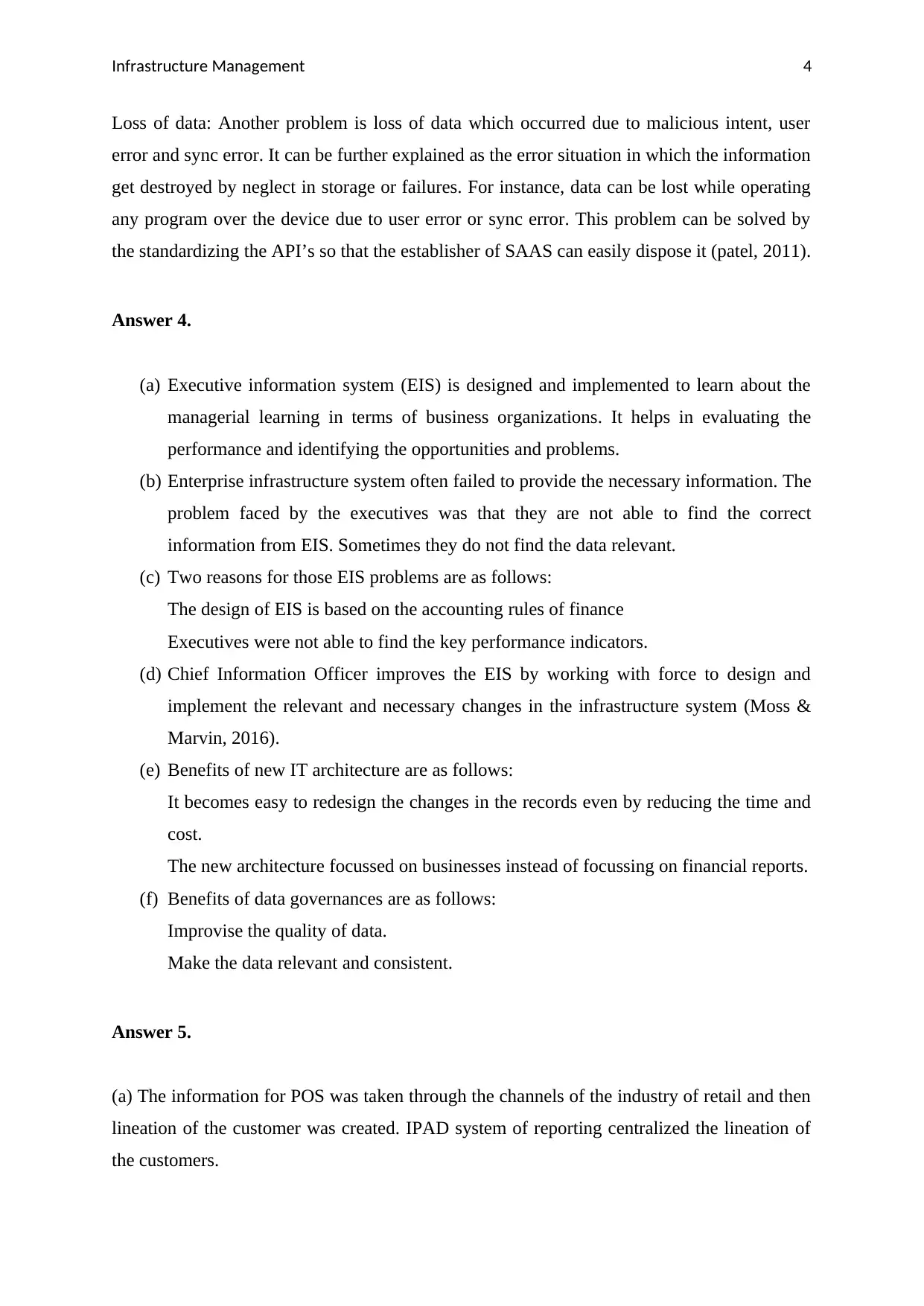
Infrastructure Management 4
Loss of data: Another problem is loss of data which occurred due to malicious intent, user
error and sync error. It can be further explained as the error situation in which the information
get destroyed by neglect in storage or failures. For instance, data can be lost while operating
any program over the device due to user error or sync error. This problem can be solved by
the standardizing the API’s so that the establisher of SAAS can easily dispose it (patel, 2011).
Answer 4.
(a) Executive information system (EIS) is designed and implemented to learn about the
managerial learning in terms of business organizations. It helps in evaluating the
performance and identifying the opportunities and problems.
(b) Enterprise infrastructure system often failed to provide the necessary information. The
problem faced by the executives was that they are not able to find the correct
information from EIS. Sometimes they do not find the data relevant.
(c) Two reasons for those EIS problems are as follows:
The design of EIS is based on the accounting rules of finance
Executives were not able to find the key performance indicators.
(d) Chief Information Officer improves the EIS by working with force to design and
implement the relevant and necessary changes in the infrastructure system (Moss &
Marvin, 2016).
(e) Benefits of new IT architecture are as follows:
It becomes easy to redesign the changes in the records even by reducing the time and
cost.
The new architecture focussed on businesses instead of focussing on financial reports.
(f) Benefits of data governances are as follows:
Improvise the quality of data.
Make the data relevant and consistent.
Answer 5.
(a) The information for POS was taken through the channels of the industry of retail and then
lineation of the customer was created. IPAD system of reporting centralized the lineation of
the customers.
Loss of data: Another problem is loss of data which occurred due to malicious intent, user
error and sync error. It can be further explained as the error situation in which the information
get destroyed by neglect in storage or failures. For instance, data can be lost while operating
any program over the device due to user error or sync error. This problem can be solved by
the standardizing the API’s so that the establisher of SAAS can easily dispose it (patel, 2011).
Answer 4.
(a) Executive information system (EIS) is designed and implemented to learn about the
managerial learning in terms of business organizations. It helps in evaluating the
performance and identifying the opportunities and problems.
(b) Enterprise infrastructure system often failed to provide the necessary information. The
problem faced by the executives was that they are not able to find the correct
information from EIS. Sometimes they do not find the data relevant.
(c) Two reasons for those EIS problems are as follows:
The design of EIS is based on the accounting rules of finance
Executives were not able to find the key performance indicators.
(d) Chief Information Officer improves the EIS by working with force to design and
implement the relevant and necessary changes in the infrastructure system (Moss &
Marvin, 2016).
(e) Benefits of new IT architecture are as follows:
It becomes easy to redesign the changes in the records even by reducing the time and
cost.
The new architecture focussed on businesses instead of focussing on financial reports.
(f) Benefits of data governances are as follows:
Improvise the quality of data.
Make the data relevant and consistent.
Answer 5.
(a) The information for POS was taken through the channels of the industry of retail and then
lineation of the customer was created. IPAD system of reporting centralized the lineation of
the customers.
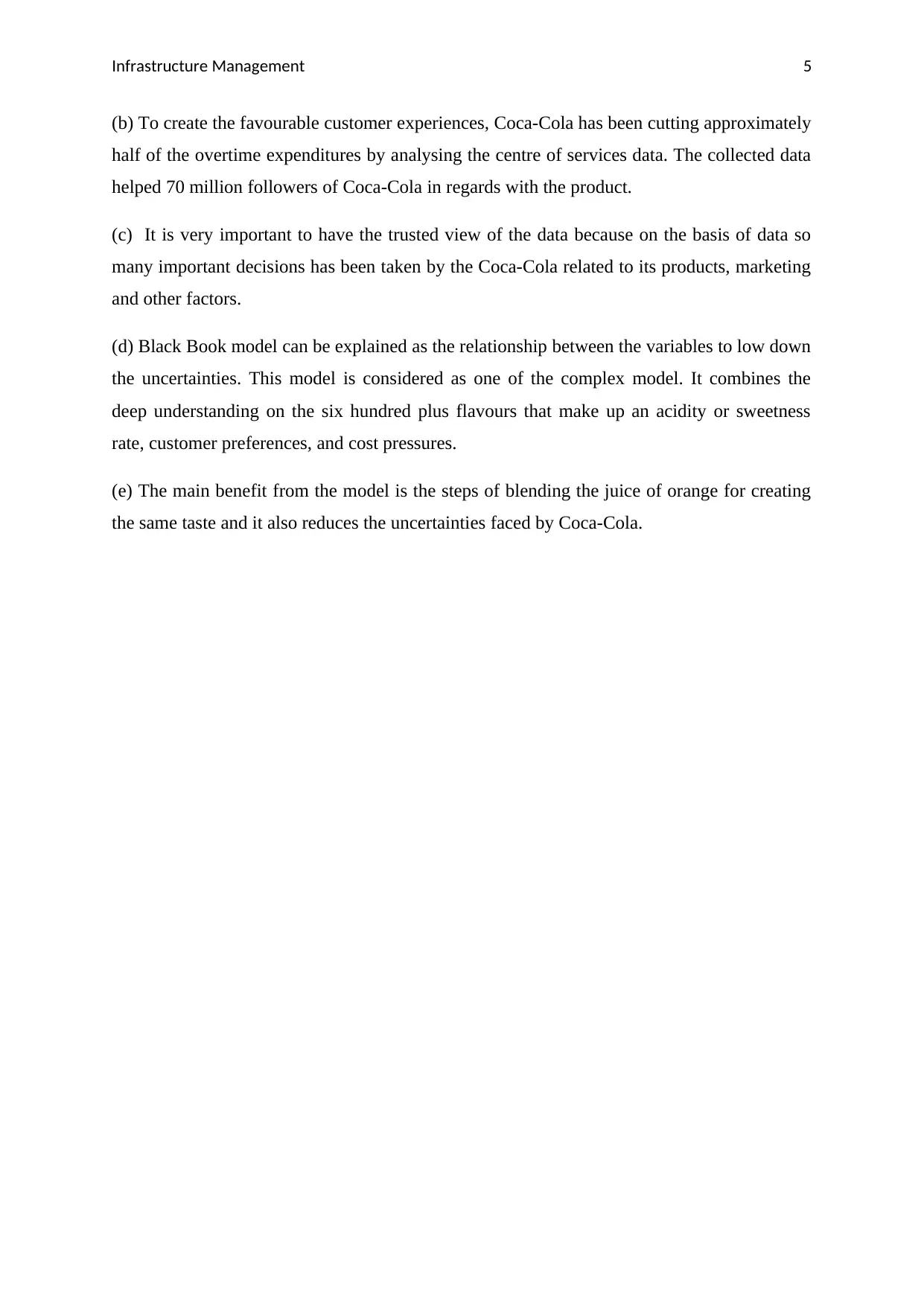
Infrastructure Management 5
(b) To create the favourable customer experiences, Coca-Cola has been cutting approximately
half of the overtime expenditures by analysing the centre of services data. The collected data
helped 70 million followers of Coca-Cola in regards with the product.
(c) It is very important to have the trusted view of the data because on the basis of data so
many important decisions has been taken by the Coca-Cola related to its products, marketing
and other factors.
(d) Black Book model can be explained as the relationship between the variables to low down
the uncertainties. This model is considered as one of the complex model. It combines the
deep understanding on the six hundred plus flavours that make up an acidity or sweetness
rate, customer preferences, and cost pressures.
(e) The main benefit from the model is the steps of blending the juice of orange for creating
the same taste and it also reduces the uncertainties faced by Coca-Cola.
(b) To create the favourable customer experiences, Coca-Cola has been cutting approximately
half of the overtime expenditures by analysing the centre of services data. The collected data
helped 70 million followers of Coca-Cola in regards with the product.
(c) It is very important to have the trusted view of the data because on the basis of data so
many important decisions has been taken by the Coca-Cola related to its products, marketing
and other factors.
(d) Black Book model can be explained as the relationship between the variables to low down
the uncertainties. This model is considered as one of the complex model. It combines the
deep understanding on the six hundred plus flavours that make up an acidity or sweetness
rate, customer preferences, and cost pressures.
(e) The main benefit from the model is the steps of blending the juice of orange for creating
the same taste and it also reduces the uncertainties faced by Coca-Cola.
⊘ This is a preview!⊘
Do you want full access?
Subscribe today to unlock all pages.

Trusted by 1+ million students worldwide
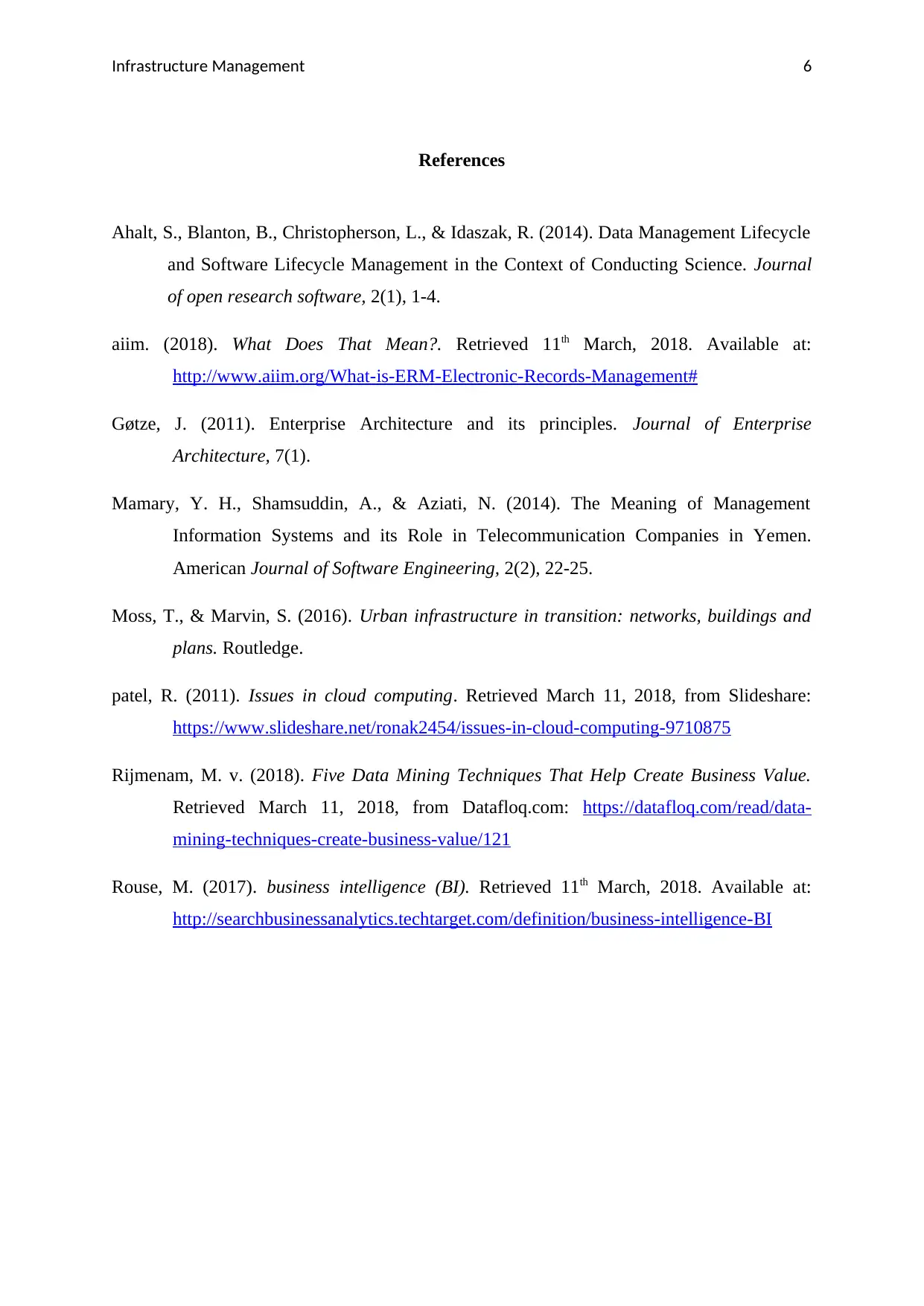
Infrastructure Management 6
References
Ahalt, S., Blanton, B., Christopherson, L., & Idaszak, R. (2014). Data Management Lifecycle
and Software Lifecycle Management in the Context of Conducting Science. Journal
of open research software, 2(1), 1-4.
aiim. (2018). What Does That Mean?. Retrieved 11th March, 2018. Available at:
http://www.aiim.org/What-is-ERM-Electronic-Records-Management#
Gøtze, J. (2011). Enterprise Architecture and its principles. Journal of Enterprise
Architecture, 7(1).
Mamary, Y. H., Shamsuddin, A., & Aziati, N. (2014). The Meaning of Management
Information Systems and its Role in Telecommunication Companies in Yemen.
American Journal of Software Engineering, 2(2), 22-25.
Moss, T., & Marvin, S. (2016). Urban infrastructure in transition: networks, buildings and
plans. Routledge.
patel, R. (2011). Issues in cloud computing. Retrieved March 11, 2018, from Slideshare:
https://www.slideshare.net/ronak2454/issues-in-cloud-computing-9710875
Rijmenam, M. v. (2018). Five Data Mining Techniques That Help Create Business Value.
Retrieved March 11, 2018, from Datafloq.com: https://datafloq.com/read/data-
mining-techniques-create-business-value/121
Rouse, M. (2017). business intelligence (BI). Retrieved 11th March, 2018. Available at:
http://searchbusinessanalytics.techtarget.com/definition/business-intelligence-BI
References
Ahalt, S., Blanton, B., Christopherson, L., & Idaszak, R. (2014). Data Management Lifecycle
and Software Lifecycle Management in the Context of Conducting Science. Journal
of open research software, 2(1), 1-4.
aiim. (2018). What Does That Mean?. Retrieved 11th March, 2018. Available at:
http://www.aiim.org/What-is-ERM-Electronic-Records-Management#
Gøtze, J. (2011). Enterprise Architecture and its principles. Journal of Enterprise
Architecture, 7(1).
Mamary, Y. H., Shamsuddin, A., & Aziati, N. (2014). The Meaning of Management
Information Systems and its Role in Telecommunication Companies in Yemen.
American Journal of Software Engineering, 2(2), 22-25.
Moss, T., & Marvin, S. (2016). Urban infrastructure in transition: networks, buildings and
plans. Routledge.
patel, R. (2011). Issues in cloud computing. Retrieved March 11, 2018, from Slideshare:
https://www.slideshare.net/ronak2454/issues-in-cloud-computing-9710875
Rijmenam, M. v. (2018). Five Data Mining Techniques That Help Create Business Value.
Retrieved March 11, 2018, from Datafloq.com: https://datafloq.com/read/data-
mining-techniques-create-business-value/121
Rouse, M. (2017). business intelligence (BI). Retrieved 11th March, 2018. Available at:
http://searchbusinessanalytics.techtarget.com/definition/business-intelligence-BI
1 out of 7
Related Documents
Your All-in-One AI-Powered Toolkit for Academic Success.
+13062052269
info@desklib.com
Available 24*7 on WhatsApp / Email
![[object Object]](/_next/static/media/star-bottom.7253800d.svg)
Unlock your academic potential
Copyright © 2020–2025 A2Z Services. All Rights Reserved. Developed and managed by ZUCOL.




